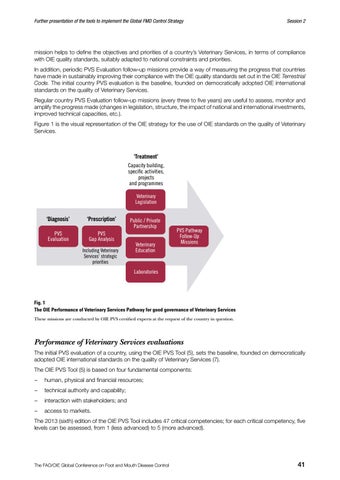Further presentation of the tools to implement the Global FMD Control Strategy
Session 2
mission helps to define the objectives and priorities of a country’s Veterinary Services, in terms of compliance with OIE quality standards, suitably adapted to national constraints and priorities. In addition, periodic PVS Evaluation follow-up missions provide a way of measuring the progress that countries have made in sustainably improving their compliance with the OIE quality standards set out in the OIE Terrestrial Code. The initial country PVS evaluation is the baseline, founded on democratically adopted OIE international standards on the quality of Veterinary Services. Regular country PVS Evaluation follow-up missions (every three to five years) are useful to assess, monitor and amplify the progress made (changes in legislation, structure, the impact of national and international investments, improved technical capacities, etc.). Figure 1 is the visual representation of the OIE strategy for the use of OIE standards on the quality of Veterinary Services.
‘Treatment’ Capacity building, specific activities, projects and programmes Veterinary Legislation
‘Diagnosis’
‘Prescription’
PVS Evaluation
PVS Gap Analysis Including Veterinary Services’ strategic priorities
Public / Private Partnership Veterinary Education
PVS Pathway Follow-Up Missions
Laboratories
Fig. 1 The OIE Performance of Veterinary Services Pathway for good governance of Veterinary Services These missions are conducted by OIE PVS certified experts at the request of the country in question.
Performance of Veterinary Services evaluations The initial PVS evaluation of a country, using the OIE PVS Tool (5), sets the baseline, founded on democratically adopted OIE international standards on the quality of Veterinary Services (7). The OIE PVS Tool (5) is based on four fundamental components: −
human, physical and financial resources;
−
technical authority and capability;
−
interaction with stakeholders; and
−
access to markets.
The 2013 (sixth) edition of the OIE PVS Tool includes 47 critical competencies; for each critical competency, five levels can be assessed, from 1 (less advanced) to 5 (more advanced).
The FAO/OIE Global Conference on Foot and Mouth Disease Control
41
















